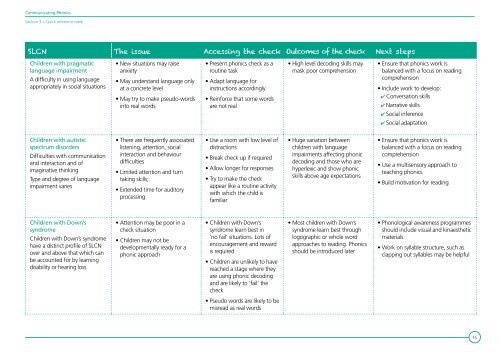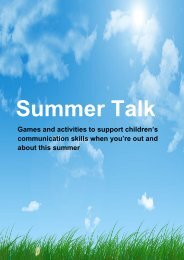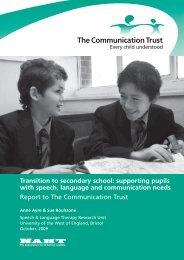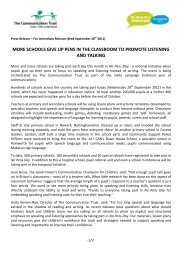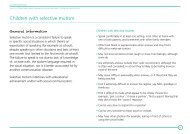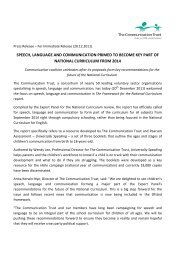Communicating Phonics - The Communication Trust
Communicating Phonics - The Communication Trust
Communicating Phonics - The Communication Trust
You also want an ePaper? Increase the reach of your titles
YUMPU automatically turns print PDFs into web optimized ePapers that Google loves.
<strong>Communicating</strong> <strong>Phonics</strong>Section 3 > Quick reference tableSLCN <strong>The</strong> issue Accessing the check Outcomes of the check Next stepsChildren with pragmaticlanguage impairmentA difficulty in using languageappropriately in social situations• New situations may raiseanxiety• May understand language onlyat a concrete level• May try to make pseudo-wordsinto real words• Present phonics check as aroutine task• Adapt language forinstructions accordingly• Reinforce that some wordsare not real• High level decoding skills maymask poor comprehension• Ensure that phonics work isbalanced with a focus on readingcomprehension• Include work to develop:✔ Conversation skills✔ Narrative skills✔ Social inference✔ Social adaptationChildren with autisticspectrum disordersDifficulties with communicationand interaction and ofimaginative thinkingType and degree of languageimpairment varies• <strong>The</strong>re are frequently associatedlistening, attention, socialinteraction and behaviourdifficulties• Limited attention and turntaking skills;• Extended time for auditoryprocessing• Use a room with low level ofdistractions• Break check up if required• Allow longer for responses• Try to make the checkappear like a routine activitywith which the child isfamiliar• Huge variation betweenchildren with languageimpairments affecting phonicdecoding and those who arehyperlexic and show phonicskills above age expectations• Ensure that phonics work isbalanced with a focus on readingcomprehension• Use a multisensory approach toteaching phonics• Build motivation for readingChildren with Down’ssyndromeChildren with Down’s syndromehave a distinct profile of SLCNover and above that which canbe accounted for by learningdisability or hearing loss• Attention may be poor in acheck situation• Children may not bedevelopmentally ready for aphonic approach• Children with Down’ssyndrome learn best in‘no fail’ situations. Lots ofencouragement and rewardis required• Children are unlikely to havereached a stage where theyare using phonic decodingand are likely to ‘fail’ thecheck• Most children with Down’ssyndrome learn best throughlogographic or whole wordapproaches to reading. <strong>Phonics</strong>should be introduced later• Phonological awareness programmesshould include visual and kinaestheticmaterials• Work on syllable structure, such asclapping out syllables may be helpful• Pseudo words are likely to bemisread as real words15


